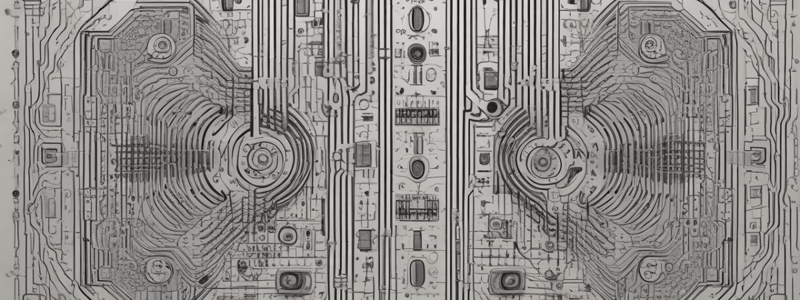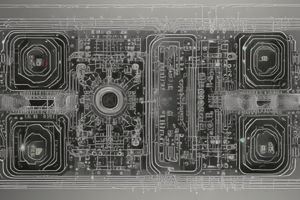Podcast
Questions and Answers
What is the primary function of a summing amplifier?
What is the primary function of a summing amplifier?
- To amplify the voltage difference between two input signals
- To combine multiple input voltages with different gains to produce a single output voltage (correct)
- To integrate the input signal with respect to time
- To provide a negative voltage gain based on the ratio of feedback resistor to input resistor
What is the key characteristic of a voltage follower (unity gain buffer)?
What is the key characteristic of a voltage follower (unity gain buffer)?
- It provides a high voltage gain based on the ratio of feedback resistor to input resistor
- It has a high output impedance and a low input impedance
- The output voltage follows the input voltage without any voltage gain, providing high input impedance and low output impedance (correct)
- It amplifies the voltage difference between two input signals
What is the primary application of an instrumentation amplifier?
What is the primary application of an instrumentation amplifier?
- Digital switching circuits
- Measurement and instrumentation applications (correct)
- Power supply regulation
- Audio signal processing
What is the function of a differentiator circuit?
What is the function of a differentiator circuit?
What is the primary function of an active filter?
What is the primary function of an active filter?
What is the primary function of a comparator in digital circuits?
What is the primary function of a comparator in digital circuits?
What is the relationship between the input and output voltages in a non-inverting amplifier configuration?
What is the relationship between the input and output voltages in a non-inverting amplifier configuration?
What is the assumption made in both inverting and non-inverting amplifier configurations?
What is the assumption made in both inverting and non-inverting amplifier configurations?
What is the purpose of the virtual short circuit concept in amplifier configurations?
What is the purpose of the virtual short circuit concept in amplifier configurations?
What is the primary difference between inverting and non-inverting amplifier configurations?
What is the primary difference between inverting and non-inverting amplifier configurations?
What is the primary function of a differentiator circuit?
What is the primary function of a differentiator circuit?
What is the mathematical representation of the output voltage of a differentiator circuit?
What is the mathematical representation of the output voltage of a differentiator circuit?
What is the primary function of a differential amplifier?
What is the primary function of a differential amplifier?
What is the primary application of an op-amp configured as an adder?
What is the primary application of an op-amp configured as an adder?
What is the key difference between a differentiator and a differential amplifier?
What is the key difference between a differentiator and a differential amplifier?
What is the main advantage of a log amplifier in analog signal processing?
What is the main advantage of a log amplifier in analog signal processing?
What is the purpose of an antilog amplifier?
What is the purpose of an antilog amplifier?
What is the effect of amplitude clipping in analog audio or video systems?
What is the effect of amplitude clipping in analog audio or video systems?
What is the common application of diode clipping in electronic circuits?
What is the common application of diode clipping in electronic circuits?
What happens when an op-amp reaches its power supply limits?
What happens when an op-amp reaches its power supply limits?
What is the result of digital signal exceeding the maximum representable value?
What is the result of digital signal exceeding the maximum representable value?
What is the purpose of dynamic range compression in audio applications?
What is the purpose of dynamic range compression in audio applications?
What is the primary function of clamping in electronics?
What is the primary function of clamping in electronics?
What is the effect of clipping on a signal?
What is the effect of clipping on a signal?
What is the purpose of clamping in video signal processing?
What is the purpose of clamping in video signal processing?
What is the primary function of a clamping circuit?
What is the primary function of a clamping circuit?
What is the role of the capacitor in a clamping circuit?
What is the role of the capacitor in a clamping circuit?
What is the purpose of using operational amplifiers as comparators?
What is the purpose of using operational amplifiers as comparators?
What is the configuration of an op-amp when used as a comparator?
What is the configuration of an op-amp when used as a comparator?
What is the output of an inverting comparator when V1 is greater than V2?
What is the output of an inverting comparator when V1 is greater than V2?
What is the output of an inverting comparator when V1 is less than or equal to V2?
What is the output of an inverting comparator when V1 is less than or equal to V2?
What determines the choice of component values and circuit configuration in a clamping circuit?
What determines the choice of component values and circuit configuration in a clamping circuit?
What is the role of positive feedback in a comparator circuit?
What is the role of positive feedback in a comparator circuit?
What is the primary advantage of using a dedicated comparator IC?
What is the primary advantage of using a dedicated comparator IC?
What is the output of a comparator circuit when the input voltages are equal?
What is the output of a comparator circuit when the input voltages are equal?
What is the achieved gain of a voltage follower?
What is the achieved gain of a voltage follower?
Which feature of a voltage follower helps in minimizing loading effects on preceding stages of a circuit?
Which feature of a voltage follower helps in minimizing loading effects on preceding stages of a circuit?
In an integrator circuit, what does the capacitor do?
In an integrator circuit, what does the capacitor do?
What is the impact of frequency on the performance of an integrator circuit?
What is the impact of frequency on the performance of an integrator circuit?
Which assumption is made when analyzing the voltage follower and the integrator?
Which assumption is made when analyzing the voltage follower and the integrator?
Flashcards are hidden until you start studying
Study Notes
Linear Applications of Op-Amps
- Inverting Amplifier:
- Provides a negative voltage gain based on the ratio of feedback resistor to input resistor
- Output voltage is inverted (180 degrees out of phase) compared to the input signal
- Voltage Gain (A): A = -Rin/Rf
- Non-Inverting Amplifier:
- Offers positive voltage gain based on the ratio of feedback resistor to input resistor
- Output voltage is in phase with the input signal
- Voltage Gain (A): A = 1 + Rin/Rf
- Differential Amplifier:
- Amplifies the voltage difference between two input signals
- Summing Amplifier:
- Combines multiple input voltages with different gains to produce a single output voltage
- Integrator:
- Utilizes a capacitor in the feedback loop to integrate the input signal with respect to time
- Differentiator:
- Uses a capacitor and resistor to differentiate the input signal with respect to time
- Voltage Follower (Unity Gain Buffer):
- The output voltage follows the input voltage without any voltage gain, providing high input impedance and low output impedance
- Active Filters:
- Utilizes op-amps to create low-pass, high-pass, band-pass, and band-stop filters for signal processing
- Instrumentation Amplifier:
- Precision amplifier with high common-mode rejection ratio (CMRR), often used in measurement and instrumentation applications
- Comparator with Hysteresis (Schmitt Trigger):
- Creates a digital switching circuit with hysteresis, useful for noise immunity in digital applications
Non-Linear Applications of Op-Amps
- Comparator:
- Used in digital circuits to compare two input voltages and produce a digital output
- Zero-Crossing Detector:
- Detects the point where the input signal crosses zero, commonly used in motor control applications
- Logarithmic Amplifier:
- Utilizes the logarithmic response of a diode to provide an output voltage proportional to the logarithm of the input voltage
- Envelope Detector:
- Extracts the envelope of a modulated signal, commonly used in amplitude modulation (AM) demodulation
- Square Wave Generator (Schmitt Trigger):
- Produces a square wave output by positive feedback, creating hysteresis in the input-output characteristic
- Voltage-to-Frequency Converter:
- Converts an analog voltage signal into a frequency signal, often used in frequency modulation applications
- Sample and Hold Circuits:
- Used in analog-to-digital converters to sample an analog input voltage and hold it for a specific period before conversion
- Non-Linear Oscillators:
- Op-amps can be configured with non-linear elements to create oscillators with sinusoidal, square, or triangular wave outputs
Inverting and Non-Inverting Amplifiers
- Inverting Amplifier:
- Input signal is applied to the inverting (-) input of the op-amp
- Output voltage is inverted (180 degrees out of phase) compared to the input signal
- Voltage Gain (A): A = -Rin/Rf
- Non-Inverting Amplifier:
- Input signal is applied to the non-inverting (+) input of the op-amp
- Output voltage is in phase with the input signal
- Voltage Gain (A): A = 1 + Rin/Rf
- Common Features:
- Input Impedance: High input impedance, providing minimal loading on the input signal source
- Output Impedance: Low output impedance, allowing the amplifier to drive loads without significant voltage loss
- Ideal Operational Amplifier Assumption: Assumes ideal op-amp characteristics, such as infinite input impedance, infinite open-loop gain, and zero input bias currents
- Virtual Short Circuit: Assumes that the voltage between the inverting and non-inverting inputs is virtually zero
Differentiator and Differential Amplifier
- Differentiator:
- Performs mathematical differentiation of the input signal with respect to time
- Output voltage is proportional to the rate of change of the input voltage
- Vout(t) = -RC(dV/dt)
- Applications: Signal processing, waveform analysis, and communication systems
- Differential Amplifier:
- Amplifies the difference between two input voltages
- Output voltage is proportional to the difference between the input voltages
- Vout = Ad(Vin1 - Vin2)
- Applications: Instrumentation amplifiers, operational amplifier circuits with differential inputs, and communication systems
Op-Amp as an Adder and Subtractor
- Op-Amp as an Adder:
- Sums the voltages applied to its inverting (-) input through individual input resistors
- Output voltage is the algebraic sum of the input voltages
- Vout = -(R1/RfV1 + R2/RfV2 + R3/RfV3 + ...)
- Op-Amp as a Subtractor:
- Subtracts one input voltage from another
- Output voltage is the difference between the input voltages
- Vout = -(R1/RfV1 - R2/RfV2)
- Adder-Subtractor Circuit:
- Combines both adder and subtractor configurations to perform both addition and subtraction based on the sign of the input voltages
Op-Amp as a Log and Antilog Amplifier
- Op-Amp as a Logarithmic (Log) Amplifier:
- Output voltage is proportional to the logarithm of the input voltage
- Vout = -R2ln(R1Isat/Vin)
- Applications: Signal processing, instrumentation, and communication systems
- Op-Amp as an Antilogarithmic (Antilog or Exponential) Amplifier:
- Output voltage is proportional to the exponential of the input voltage
- Vout = -R2Isat/R1Vin
- Applications: Signal processing, instrumentation, and communication systems
Clipping
- Definition: Clipping refers to the phenomenon where part of a signal is cut off or "clipped" due to limitations in the amplitude range of a system
- Types of Clipping:
- Analog Clipping:
- Amplitude Clipping: Occurs when the signal level exceeds the maximum or minimum voltage that can be accurately represented
- Diode Clipping: Used to intentionally clip parts of a signal in electronic circuits
- Digital Clipping:
- Digital Audio Clipping: Occurs when the digital signal exceeds the maximum representable value
- Digital Image Clipping: Occurs when pixel values exceed the maximum or minimum limits that can be represented
- Analog Clipping:
- Effects of Clipping:
- Distortion: Introduces harmonic distortion to the signal
- Loss of Information: Results in the loss of information beyond the clipped levels
- Nonlinear Behavior: Introduces nonlinearity into a system, altering the relationship between input and output
- Clipping Prevention:
- Signal Level Management: Careful control of signal levels in both analog and digital systems
- Dynamic Range Compression: In audio applications, dynamic range compression can be applied to reduce the amplitude variations in a signal
- Oversampling and Dithering: In digital audio, oversampling and dithering techniques are employed to reduce the likelihood of digital clipping and mitigate its effects
Clamping
- Definition: Clamping refers to a technique used to shift or "clamp" the DC level of a signal to a desired voltage level
- Types of Clamping Circuits:
- Positive Clamping:
- Shifts the DC level of the signal upwards
- Uses diodes and capacitors in the circuit
- Negative Clamping:
- Shifts the DC level of the signal downwards
- Uses diodes and capacitors in the circuit
- Positive Clamping:
- Applications:
- DC Restoration: Often used in communication systems to remove any DC offset in the signal
- Audio Processing: Used to remove DC bias from audio signals
- Video Signal Processing: Used to set the black level in video signals### Waveform Generation
- Clamping circuits can generate specific waveforms with desired DC levels.
- The capacitor in the clamping circuit plays a crucial role in storing and releasing charge during different parts of the input signal cycle.
Comparator Circuits
- Comparators compare two input voltages and produce an output indicating which one is larger.
- Op-amps can be used as comparators by configuring them in open-loop mode with positive feedback.
- The output of a comparator will swing between its positive and negative saturation levels based on the comparison of the input voltages.
Inverting Comparator
- An op-amp is set up as an inverting comparator.
- The output will swing between its positive and negative saturation levels based on the comparison of the input voltages.
- When V1 > 0, the output saturates negatively.
- When V1 < 0, the output saturates positively.
Voltage Follower
- A voltage follower is a simple op-amp circuit configuration where the output voltage follows the input voltage with a gain of approximately one (unity).
- Characteristics:
- Unity gain
- High input impedance
- Low output impedance
- No phase shift
- Applications:
- Isolate or buffer one part of a circuit from another
- Match impedances between different parts of a circuit
- Mathematical representation: Av ≈ Vin/Vout ≈ 1
Integrator
- An integrator is a type of op-amp circuit configuration that performs mathematical integration of the input signal with respect to time.
- Output voltage is proportional to the integral of the input voltage over time.
- Operational principle:
- Input signal is applied to the inverting input of the op-amp through a resistor
- Feedback path includes a capacitor connected between the output and the inverting input of the op-amp
- Capacitor integrates the input voltage over time
- Characteristics and features:
- Integration function
- Low-frequency dominance
- Steady-state behavior
- Virtual ground concept
- Mathematical representation: Vout = -RC∫Vindt
- Applications:
- Signal integration
- Measuring the cumulative effect of a varying input signal
Studying That Suits You
Use AI to generate personalized quizzes and flashcards to suit your learning preferences.





